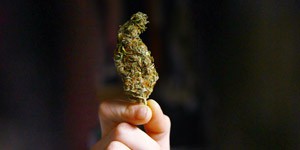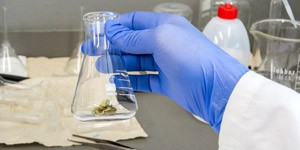By Mariano Garcia de Palau

Born in Barcelona, 17 February 1956. Graduated in medicine and surgery from the University of Barcelona in 1979. For 38 years has worked as an emergency physician in the area of occupational medicine. He became interested in cannabis by chance, and for the last 15 years has studied its therapeutic uses.
Currently he continues to advise on cannabinoid treatments and performs clinical work with patients, collaborates with various organizations and associations, serves as Senior Consultant for Grupo Curativa Colombia and is a spokesperson for the Spanish Medical Cannabis Observatory.
In 2013, CNN released a documentary featuring Charlotte Figi, a child with Dravet syndrome, one of several types of syndromes associated with refractory epilepsy (i.e. epilepsy that is unresponsive to treatment). This little girl suffered hundreds of seizures a day, and her prescribed medication did not keep them in check efficiently. Treatment with a CBD-rich cannabis oil was a turning point, both for her and for many families who became interested in the treatment and even travelled to Colorado to obtain the oil that had changed little Charlotte's and her family's lives.
The oil managed to keep her seizures in check. Charlotte's progress was very positive, which is important because too many crises in small children keep them from learning or interacting with their environment. They may have neuronal damage and they often present a major developmental delay; in short, they are in bad condition and cannot really live as children. In the end, she died from COVID19, which had nothing to do with her illness. Up to 2013, cases of children treated with cannabinoids were mostly anecdotal and highly uncommon, with only the occasional news piece or publication to be read. However, Charlotte contributed decisively to us revisiting the systematic use of cannabis in children with certain pathologies.
We started working with children, using CBD-rich extracts for patients affected by any type of refractory epilepsy. I refer to CBD-rich oils, which contain part of the complete plant. Not only CBD is found in these oils, as they contain other cannabinoids, including THC, in certain proportions. The terpenes from the variety used to prepare the extract are also present.
A few years later, Big Pharma took an interest in the CBD molecule and commenced a clinical assay with pure CBD to treat Dravet Syndrome and Lennox-Gastaut syndrome. At present, the product is available as a medication, named Epidiolex, which the producers priced at 30,000 Euro a year. Suitably tested CBD-rich oils currently found on the market may cost up to 10 times less, depending on the patient's weight.
In my opinion, treating epilepsies with CBD reopened the debate concerning the use of cannabinoids in paediatrics, which has always been linked to the use of THC without considering the use of isolated CBD or legal concentrations of THC, which vary in each country. Furthermore, for many of us health professionals who work with cannabis, it is evident that THC is the basic molecule for most treatments, in certain doses and different proportions or ratios that must be adjusted for each patient depending on his or her biometric characteristics and pathology.
It is also evident that the Endocannabinoid System (ECS) regulates brain development starting in the embryonic stage. Therefore, could we induce an irreversible change that would generate a cognitive disorder if we were to provide treatment through the ECS? This question has been studied very little and always in relation to the use of THC, which activates the CB1 and CB2 receptors in the ECS, among others.
There are many indirect indications that point to a relevant role played by endocannabinoids during the development of the Central Nervous System. First, the density, localisation and activity of the CB1 receptors in the brain vary from prenatal to neonatal stage, and from then to adulthood.
These receptors are abundantly expressed in the foetus and newborn in "atypical areas", such as the subventricular region, neocortex, brainstem and, most strikingly, in the white matter, particularly in commissural fibres such as the corpus callosum or anterior commissure. All of these localisations disappear in the adult; very few of the receptors found in adults are found in the foetus and newborn. The abundance of CB1 receptors in regions that are typical in adults explains the psychoactive effects of cannabinoids. Conversely, the different distribution of receptors may explain how no such effects were observed in children with cancer who were treated with cannabinoids such as THC or CBD while undergoing anti-emetic or analgesic treatments (1). Paediatric patients with different types of cancer being treated with THC do not present the same symptoms as adults regarding the psychoactive effect of THC, and they tolerate it well without presenting side effects. I refer to supportive care with cannabinoids used to increase appetite, control pain, improve sleep and mood, or relieve nausea during chemotherapy cycles, which is by no means negligible. Side effects are rare. The antitumour effect of cannabinoids themselves can clearly help oncological treatment. However, more clinical assays are needed to prove which cannabinoids are the most effective molecules for different types of cancer, the specific dose at which they should be administered, and the length of time during which we should provide treatment with them. Consider how common chemotherapy drugs are administered concomitantly, in some cases, and during different treatment cycles. Patients are treated with THC and CBD at different ratios and dosages adapted to their weight and treatment tolerance.
As for CBD, even the WHO has issued a positive opinion regarding its use. For now, clinical experience confirms these expectations of safe use with few side effects, and no drug tolerance or addiction (2).
Thus far we have commented on their use in epilepsy and oncology, but here are other indications with very interesting results. For example, we found that 30% of patients diagnosed with Autistic Spectrum Disorder (ASD) present refractory epilepsy as an associated disorder. Imagine a child who has trouble communicating with people, controlling feelings, processing information, and who also has seizures that do not respond to prescribed medication. In cases of refractory epilepsy, as well as oncological cases, we start from highly complex illnesses that can give rise to serious or even life-threatening conditions for children. We believe that treatment with cannabis is justified thanks to the low toxicity of cannabinoids, its safe handling, and the few side effects presented by patients, which are foreseeable and easily solvable.
Results are very interesting in patients with ASD and refractory epilepsy, particularly when we can improve seizure patterns and decrease the number of crises, their intensity or their frequency of occurrence. All things considered, we can improve cognitive performance, behavioural issues, self-injury due to frustration, associated hyperactivity in some cases, attention, and interaction with the environment. It must also be noted that treatment with cannabinoids is effective in controlling daytime stereotypy (repetitive movements). The nocturnal bruxism presented by many of these patients also improves or disappears. While we cannot eradicate the disorders, the results are compelling and the low toxicity of cannabinoids make them safe for use in paediatric patients, who frequently have no effective prescribed treatment, or do have an effective treatment whose use must be evaluated given its serious side effects, which could contraindicate such therapy. The therapeutic options and possible interactions with other prescribed medication must always be assessed in each case before starting treatment with cannabinoids; and of course, parents have the right to choose the treatments provided to their children.
There are many more indications than those mentioned here, in which use of cannabinoids can be assessed. This should be seen as a proposal for the study of indications.
Inflammatory bowel diseases, such as ulcerative colitis or Crohn's disease, spasticity associated to neurological disorders, ADHD, sleep disorders, motor disorders and muscular dystonias, brain paralysis, paediatric palliative care, and also rare disorders, which include a large number of low-incidence pathologies that are not profitable for drug research since they only affect 0.05% of the population in Europe. There is no treatment for about 4,000 disorders. Here we can analyse these patients' symptoms to evaluate whether cannabinoids can be used to improve their quality of life, especially when specific treatments are absent. Most of our patients have rare illnesses, and it is important to be able to take positive action both for the patient and for his or her environment. Patients with rare disorders can improve their quality of life when no other therapeutic alternatives are available.
Use of cannabis in paediatrics must therefore be considered. We often confront serious diseases that have no effective treatment and that could be treated with molecules whose toxicity is very low and whose side effects are foreseeable and easily solvable.
References:
1. El sistema cannabinoide y su importancia en el período perinatal.
J.A. Martínez Orgado D. Fernández López B. Bonet Serra Lizasoain Hernández y J. Romero Paredes
2. CANNABIDIOL (CBD) Critical Review Report
Expert Committee on Drug Dependence, Fortieth Meeting, Geneva, 4-7 June 2018, © World Health Organization 2018


